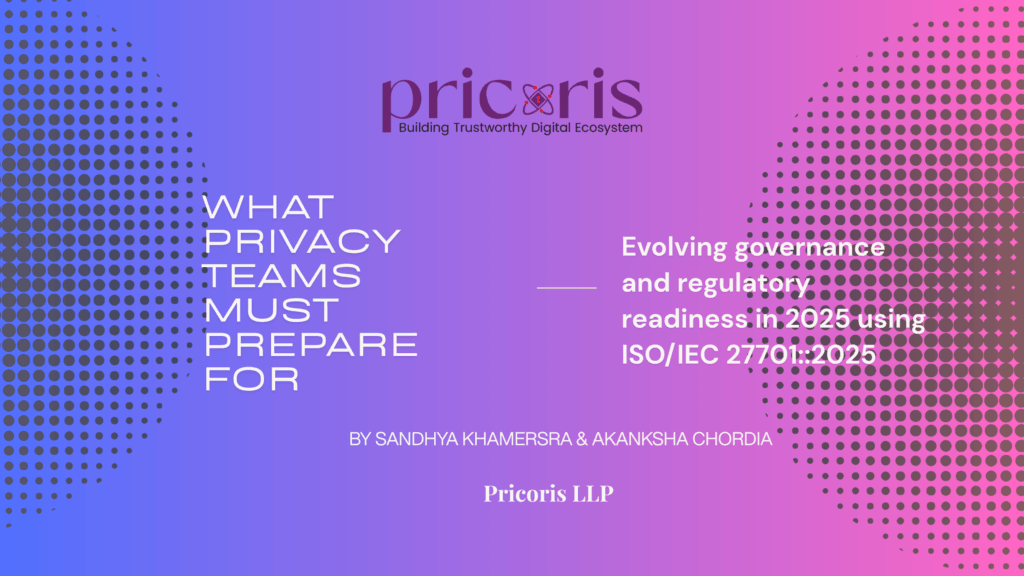
Introduction – Privacy Governance Comes of Age
When ISO/IEC 27701 was first released in 2019, it was designed as an extension of ISO 27001-a bridge between information security and data protection.
Five years later, ISO/IEC 27701:2025 quietly but decisively redefines that bridge.
The new edition transforms the Privacy Information Management System (PIMS) from a compliance overlay into an independent, measurable governance framework that aligns with today’s laws-India’s DPDP Act 2023, Europe’s GDPR, and the global trend toward accountability, not delegation.
This update is not cosmetic. It fundamentally changes how organizations plan, assess, and demonstrate privacy assurance-across leadership, risk, operations, and reporting.
At Pricoris LLP, we’ve analysed the final 2025 edition and distilled the 10 operational impacts every privacy, risk, or compliance leader must address.
Seven of these will feature in our #PrivacyFridays LinkedIn series-but here you’ll find the full list, complete with key clauses, practical guidance, and why each change matters.
1. Climate and Context – Privacy Meets Resilience
Clause 4.1 | External & Internal Issues
Environmental and geopolitical disruptions-floods, heatwaves, supply-chain failures-now explicitly count as contextual issues that can affect privacy operations.
A robust PIMS links continuity (ISO 22301) with privacy (ISO 27701) and security (ISO 27001).
Action: Add climate-resilience and operational-continuity scenarios to your context register and BCP testing.
2. Broadened Definition of “PII Principal”
Note 4 to Clause 4.2
A “PII Principal” now includes any individual whose PII you process-consumer, employee, vendor, visitor.
This aligns ISO 27701 with GDPR and DPDP terminology.
Action: Expand scope statements, data-flow maps, and rights-handling procedures to include internal and external data subjects.
3. Leadership = Accountability
Clauses 5.1 – 5.3
The 2025 edition deletes the note that allowed top management to assign reporting responsibility.
Reporting may be delegated-accountability cannot.
Leadership must own privacy KPIs, DPIAs, and risk oversight.
Action: Organizations should establish board-level PIMS reviews with defined privacy metrics and escalation paths.
4. Privacy Objectives in stead of Security Objectives
Clause 6.2
Objectives are no longer an ISMS extension; they are now aligned directly with the privacy policy and legal obligations.
KPIs shift from ISMS KPIS like technical uptime to Privacy KPIs like data subject rights assurance-Data Subject Requests turnaround, consent, accuracy, and transparency.
Action: Organizations should set quarterly privacy KPIs linked to Board scorecards and risk plans.
5. Risk Assessment – From CIA to Human Harm
Clause 6.1.2 | Aligned to ISO/IEC 27557
Risk assessment is now a stand-alone privacy process that looks beyond Confidentiality, Integrity, and Availability.
It evaluates severity, scale, sensitivity, reversibility, and likelihood of harm to both the organization and PII Principals.
Action: Replace CIA-only matrices with dual-impact scoring based on ISO 27557 criteria.
6. Risk Treatment – From Refinement to Accountability
Clause 6.1.3
Privacy risk treatment is no longer a subset of ISMS. Organizations must build a Privacy SoA and a Privacy Risk Treatment Plan drawing from:
1) Annex A (privacy controls) 2) ISO 27002 (security controls) 3) Annex B (implementation guidance).
Action: Organizations should maintain distinct SoAs for Privacy and Security with evidence of risk linkages and legal references.
7. Support – Same Structure, New Context
Clause 7
Adequacy of resources, privacy competence, privacy awareness, and PIMS documentation are now privacy-anchored.
Training must cover lawful basis, notices, DPIAs, privacy breaches, vendor roles-not just technical security.
Action: Organizations should refresh competency matrices and awareness modules with privacy-specific content.
8. Performance Evaluation – Measuring Trust, Not Controls
Clause 9.1
For the first time, organizations must evaluate privacy performance and PIMS effectiveness-independently of the ISMS audit cycle.
KPIs include DPIA coverage, DSR SLA, consent accuracy, and vendor assurance.
Action: Organizations should build a privacy-performance dashboard with quarterly reviews and trend tracking.
9. Management Review – Addition of Stakeholder Trust and Trends
Clause 9.3
New inputs to management review include “needs and expectations of interested parties” and “privacy performance trends.”
This shifts Boardroom focus from control status to interested parties trust.
Action: Include stakeholder expectation surveys and trend analytics in management reviews.
10. Improvement – Continuous Assurance with focus on reduction in Privacy Harms
Clauses 10.1 – 10.2
Corrective actions and continual improvement now focus on preventing privacy harm and demonstrating regulatory compliance.
It’s not just about closing non-conformities – it’s about reducing real-world impact on people.
Action: Tag every CAPA to a specific harm scenario and relevant legal clause (GDPR Art 5 / DPDP §10).
Get Ready with Pricoris LLP
PIMS Readiness Assessment
Want to evaluate your organization’s readiness for ISO/IEC 27701:2025?
Our consultants help you map gaps, update risk registers, and align privacy controls with ISO 27557 and the DPDP Act.
📧 info@pricoris.com | 🌐 www.pricoris.com
PIMS Training Programmes – Now Open for 2025 Edition
- 1-Day Transition Course – for teams already certified on ISO 27701:2019 and seeking to understand new requirements, Annex updates, and ISO 27557 linkages.
- 4-Day Implementation Training – a hands-on programme covering policy updates, risk assessment criteria, privacy KPIs, and governance integration.
Delivered by Pricoris experts who worked on live 27701 and 42001 implementations across industries.
Custom onsite or virtual batches available.
Write to training@pricoris.com to reserve your slot.
Pricoris LLP | Building Responsible AI & Privacy Systems
